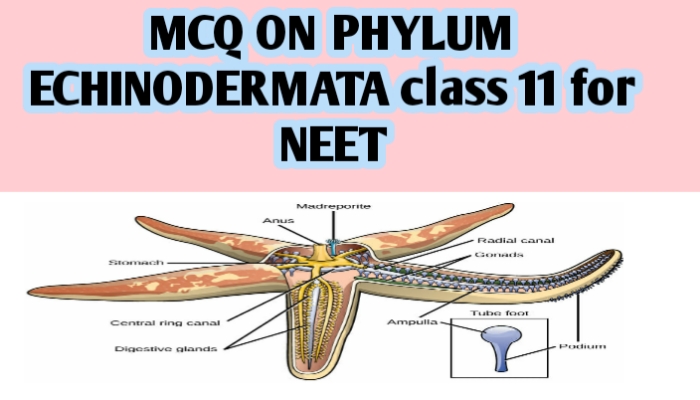MCQ ON PHYLUM ECHINODERMATA class 11 for NEET | MCQ ON NEET Biology class 11th 2022 | MCQ Questions for class 11 Biology chapter – 4 PHYLUM ECHINODERMATA with Answer | Check the below NCERT MCQ question for class 11 Biology chapter 4 based on PHYLUM ECHINODERMATA with Answers.

MCQ ON PHYLUM ECHINODERMATA class 11 for NEET
MCQ Questions for class 11 Biology with Answers were prepared based on the latest pattern.We have provided class 11 Biology MCQs questions on PHYLUM ECHINODERMATA with Answers to help students understand the concept very well.
MCQ on Phylum ECHINODERMATA is useful for NEET / CSIR / UGC / CBSE / ICSE / AIIMS / EXAM / AFMC EXAM / STATE LEVEL MEDICAL EXAM 2022-23
Introduction:-
Phylum Echinodermata includes the starfish , brittle star , sand dollars , sea urchin. sea cucumber and sea lilies.
The body has various shape star like, cylindrical , melon like , disc like . It is u segmented . The symmetry is radial in the adults and bilateral in the larvae.They are triploblastic animals.They have organ system level of organisations.The body lacks head in all echinoderms. Peculiar tube feet podia are developed for locomotion.
MCQ ON PHYLUM ECHINODERMATA class 11 for NEET
1.These animals have an endoskeleton of calcerous ossicles and hence , the name
(a) arthropoda
(b) Cnidaria
(c) annelida
(d) echinodermata
Ans (d) echinodermata
2. Echinodermata are marine with
(a) cell level organisation
(b) tissue level organisation
(c) organ level organisation
(d) organ – system level of organisations
Ans. (d) organ – system level of organisations
3. The important features of echinodermata are
(a) bilaterally symmetrical
(b) triploblastic
(c) coelomate animals
(d) all the above
Ans. (d) all the above
4. The most distinctive features of echinoderms is the presence of
(a) chitinous exoskeleton
(b) calcareous shell
(c) camal system
(d) water vascular system
Ans.(d) water vascular system
ALSO READ:-
● YOU CAN WATCH BIOLOGY SIR Youtube channel
5.The water vascular system of echinodermata helps in
(a) locomotion
(b) capture
(c) transport of food and respiration.
(d) all the above
Ans.(c) all the above
6.The sea Urchin is
(a) echinus
(b) asterias
(c) antedon
(d) cucumaria
Ans.(a) echinus
7. Sea lily is
(a) antedon
(b) ophiura
(c) Asteria
(d) echinus
Ans.(a) antedon
8. Ophiura is
(a) echinus
(b) brittle star
(c) sea cucumber
(d) asterias
Ans.(b) brittle star
9. Sea cucumber is
(a) cucumaria
(b) ophiura
(c) echinus
(d) meriradula
Ans. (a) cucumaria
10. Excretory system is absent in
(a) mollusca
(b) annelids
(c) echinodermata
(d) arthropoda
Ans. (c) echinodermata
11. The digestive system is complete with mouth on lower ventral side and anus on the upper dorsal side.Identify the phylum
(a) mollusca
(b) annelids
(c) arthropoda
(d) echinodermata
Ans.(d) echinodermata
12. Respiration in echinodermata is done by
(a) canal system
(b) water vascular system
(c) gills
(d) gill book
Ans.(b) water vascular system
13. Characteristic tube feet help in
(a) locomotion
(b) nutrition
(c) respiration
(d) excretion
Ans.(a) locomotion
14. The degenarate features of echinoderms is
(a) lack of head
(b) reduced circulatory system
(c) absence of excretory system
(d) all the above
Ans.(d) all the above
15. The echinodermata resemble chordates , particularly vertebrate , in having
(a) radial and indeterminate cleavage of frog
(b) mesodermal endoskeleton
(c) deuterostomous mouth
(d) all the above
Ans. (d) all the above
16. Asteroidea , ophiuroidea , echinoidea , holothuroidea and crinoidea are classes of ?
(a) annelids
(b) echinodermata
(c) mollusca
(d) aschelminthes
Ans.(b) echinodermata
17. Larva of starfishes
(a) bipinnaria
(b) ophiopluteus
(c) auricularia
(d) crinoidea
Ans.(a) bipinnaria
18. The larva of sea archins is
(a) echinopluteus
(b) auricularia
(c) crinoidea
(d) plasmodium
And.(a) echinopluteus
19. Respiration occurs by gills called dermal branchiae or papilae in
(a) brittle star
(b) starfishes
(c) sea urchin
(d) sea cucumber
Ans. (b) star fishes
20. The brittle star is
(a) ophiothrix
(b) mytilus
(c) pinctada
(d) echinus
Ans.(a) ophiothrix







Leave a Comment